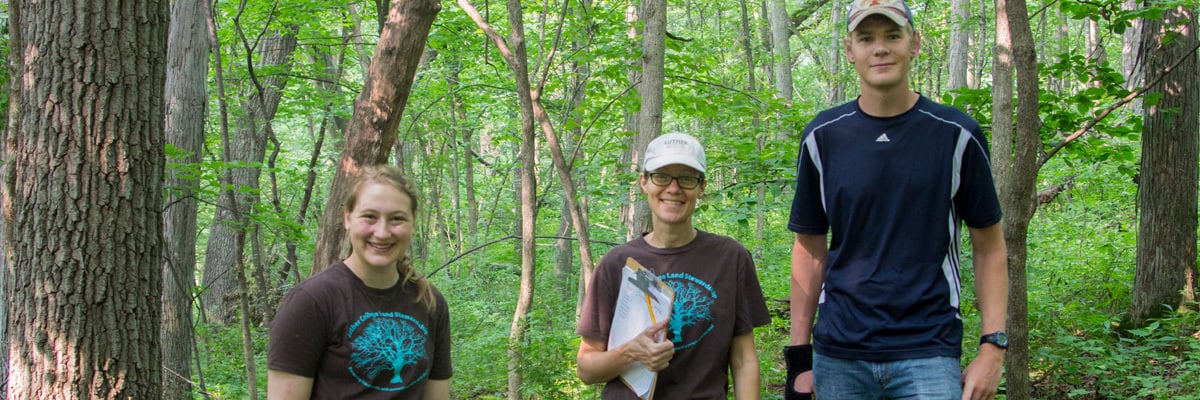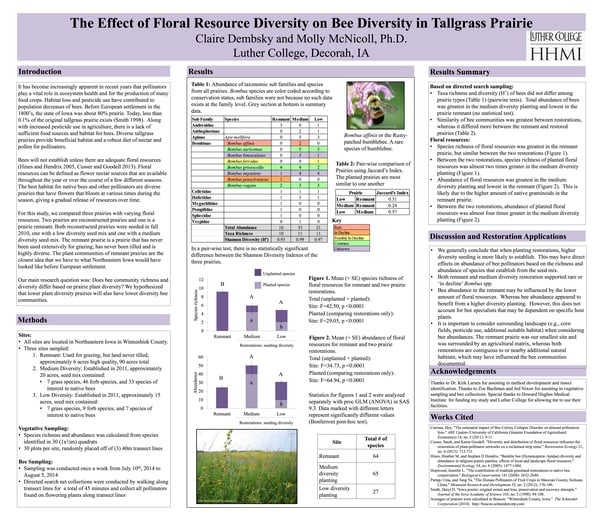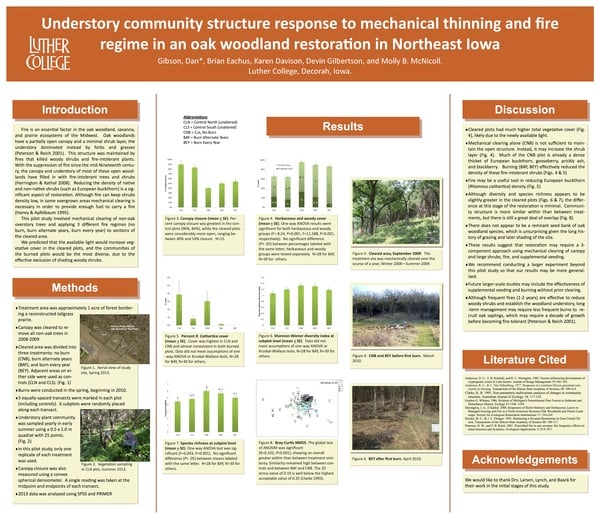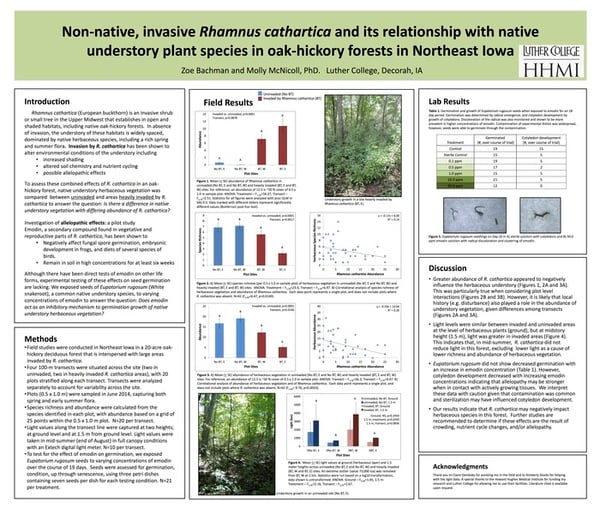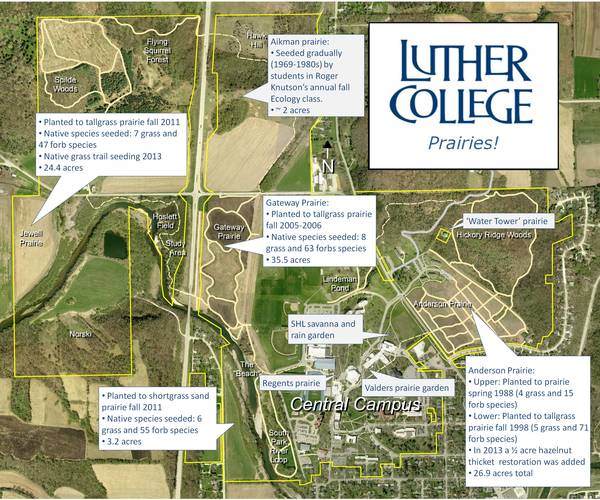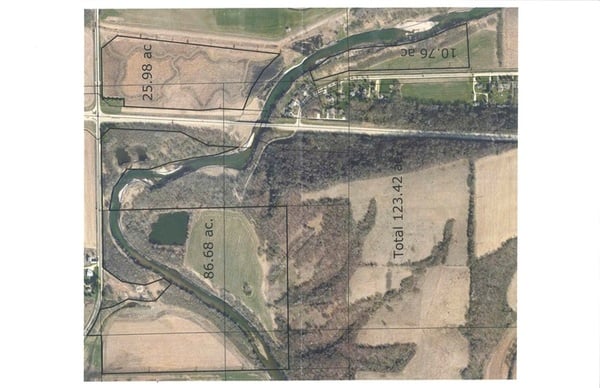An Iowa College in the Liberal Arts Tradition
Biology
Active Stewardship and Research
Luther’s natural areas include many remnant and restored habitats, with diverse native plant and animal communities. Many of our woodlands are relatively intact, but historically common habitats, including prairies, oak woodlands, and savannas, were lost or altered by past land use. To maintain the diversity of our existing habitats and replace those that were converted, faculty, staff, and students restore and actively steward these habitats. Activities vary from site-to-site and may include: monitoring for and removing invasive species, re-planting native species, and/or re-introducing appropriate processes such as fire.
- Students interested in land stewardship opportunities, including internships, should contact Dr. McNicoll.
- Students interested in research opportunities related to restoration, ecology, wildlife biology, entomology, botany on Luther’s or other natural areas, please inquire with any of the following professors in the Biology department: McNicoll, Lynch, Larsen, Reding, or Baack.
(See images for student research poster examples.)
Active restoration started on Luther’s lands in 1969, when biology professor Roger Knutson and his fall Ecology class started an annual project of adding small amounts of prairie seed to a former 2-acre pasture, which continued until 1980 (Aikman Prairie). Larger scale prairie plantings occurred in the late 1980s and 1990s (Anderson Prairie) and 2005 (Gateway prairie). The work of planting native habitats continues: Since 2011, Luther has replanted 13 acres of bottomland forest, 25 acres of prairie along the Upper Iowa River, and nearly 3 acres of prairie designed to research pollinator habitat.
Prairie Restoration: The college natural areas include 90 acres of restored prairies. The primary goals for these plantings are:
- Increased native diversity and habitat (plants, insects, birds, etc.)
- Opportunities for classroom use and scientific research
- Reduced soil erosion
- Sediment retention during floods
- Foster human connections to a habitat once common amidst a mosaic of forests, woodlands, and savannas in the region
To see a map highlighting the different prairies, view the map image on this page or go to the natural areas descriptions for more information.
Forest Restoration: We are lucky to have large areas of relatively intact, native dominated woods and forests. Most of our active woodland management is focused on maintaining this diversity, controlling invasive species, and where appropriate, re-introducing natural disturbances, including prescribed burns.
Follow the trails from campus to visit oak-hickory forests and woods, including Hickory Ridge Woods, Hoslett Study area (located along the Upper Iowa River), and Flying Squirrel Woods and Spilde Woods, which are part of Roslien Woods.
Lionberger Environmental Preserve (5 miles east of campus on Pole Line Road) and Weigle-Roslien Tract (15 minutes north of Decorah) are the college’s best examples of intact woodlands with fantastic wildflower displays in the spring. In these woods, we are managing for invasive species, such as garlic mustard and Japanese barberry.
Prescribed fire in our woodlands
Low intensity ground fires were a part of the historical natural disturbance regime of many of our open woodlands. Although, not all of our NE Iowa woods are adapted to fire and would be damaged by fire, so we apply it very selectively. In fall 2015, prescribed fire was introduced to Flying Squirrel Woods, as part of a research project to enhance native plant diversity and decrease European buckthorn. The west side of Hickory Ridge Woods (behind the big red barn) was also burned in fall 2015 to reduce buckthorn abundance and initiate restoration of what appears to be remnant oak savanna and prairie. A pilot project in Hickory Ridge Woods in 2009 allowed us to experiment with forest canopy thinning and spring prescribed fire (visible on the slope behind Baker Commons).
Forest plantings: In the fall 2011 and spring 2012, we planted ~14 acres of bottomland forest along the Upper Iowa River at Norski Bottoms. Nine native tree species were planted using two different planting methods: half of the area was planted with seedlings in traditional plantation rows, and half was planted using direct seeding (walnut and ash seed was sown in the fall, supplemented with oak seedlings in the spring). A mature plantation of non-native conifer and native hardwood tree species can be seen in Roslien Woods, ~50 acres planted in the 1980s to improve eroding cropland.
Want to plant a prairie or forest of your own?
Prairie and woodland plants and seed native to northeast Iowa can be purchased from several regional dealers including: Prairie Moon Nursery, Ion Exchange native plant nursery, Shooting Star native plant nursery, Iawisil native forest nursery, among others. Be sure to specify to the nursery that you want ‘local ecotype’ seed or plants to ensure you receive plants with genetics from your local area (e.g., rather than the same species, but whose seed was collected from northern Minnesota).
Managing invasive species: Invasive species are non-native species that cause economic or ecological/environmental harm. Invasive species such as European buckthorn and garlic mustard negatively impact native communities in many ways, such as decreasing the germination, growth, and flowering of native trees and wildflowers, altering food sources for native pollinators and insects, and even changing soils nutrient cycles. To make the best decisions for healthy habitats and prioritize our efforts, we consider several things:
- Which species to manage? Species are prioritized if they are known to have negative ecological effects or negative effects on humans who visit the natural areas. Using research literature as the basis, the species that we manage have caused, or are likely to cause, significant negative impacts if not removed.
- Why not just remove all non-native species? Many non-native species are not invasive. Nor are all commonly viewed ‘weeds’ the source of ecological harm. Additionally, the disturbance of removing invasive species can make a problem worse if not accompanied by appropriate follow-up measures.
- How is management prioritized? Highest priority areas are high quality native habitat—it is better to protect quality habitats now, than to try and re-build them later. Another priority includes areas with low abundance of the invasive species. For example, it is more effective to remove sub-adult buckthorn at low density than to wait 5 years and have to contend with mature buckthorn and lots of seedlings. It is also beneficial to manage areas that may be a significant seed source for adjacent native habitats (i.e., high potential for further invasion).
We use a combination of methods that take into account the life cycle of the plant, the mode of reproduction, and the most efficient means with the least side effects. This includes pulling seedlings, cutting and treating stumps with herbicide to prevent re-growth, leaf-applied herbicide in moderation, and prescribed fire.
Invasive species management is almost never a one-time treatment. We monitor areas after they have been treated, and many areas require multiple years or decades of management. In addition, once the invasive is sufficiently reduced, we may also need to supplement with native seed or plantings.
If you are in identifying or managing invasive species on your own property, including proper identification, stages for control, and species-specific best methods, the following resource offer reliable information.
Book: Invasive Plants of the Upper Midwest by Elizabeth Czarpata. 2005.
Web:
- Midwest Invasive Species Information Network (MISIN)
- Midwest Invasive Plant Network (MIPN)
- Center for Invasive Species and Ecosystem Health
Species we are currently managing are listed below. For identification and more information on these species, see the previously-listed resource links.
- Woody invasive species: European buckthorn (Rhamnus cathartica), honeysuckle (exotic Lonicera spp.), Japanese barberry (Berberis thunbergii). Common to abundant in several of our woodlands.
- Garlic mustard (Alliaria petiolata). Common to abundant in several of our woodlands.
- Wild parsnip (Pastinaca sativa). Wild parsnip is a relatively recent introduction and quickly spreading, especially along mowed roadway edges and low diversity grasslands. It is highly toxic to human skin in the presence of sunlight.
Species with varying abundance that we are also managing:
- Cypress spurge (Euphorbia cyparissias)
- Japanese hops (Humulus japonicus). Beware: Know your identification—there is a native, non-invasive vine that looks very similar!
- Japanese knotweed, Japanese bamboo, or Giant knotweed (Fallopia japonica, other scientific names also apply). This is an emerging threat along the Upper Iowa River and tributaries.
- Multiflora rose (Rosa multiflora)
- Crown vetch (Securigera varia)
- Canada thistle (Cirsium arvense)
- Reed canary grass (Phalaris arundinacea)
- Sweet clover (Melilotus alba and M. officinalis)
Species on our watch list (not present on the natural areas as of yet):
- Asian bittersweet (Celastrus orbiculatus) Beware: Know your identification—there is a native, non-invasive vine that looks very similar!
- Knapweed (Centaurea sp.)
- Siberian squill (Scilla siberica)
All of Luther’s natural areas are managed under the college’s land stewardship plan, but some areas have been allocated to various conservation easements. See a map of land protected as part of the Emergency Watershed Protection program.

